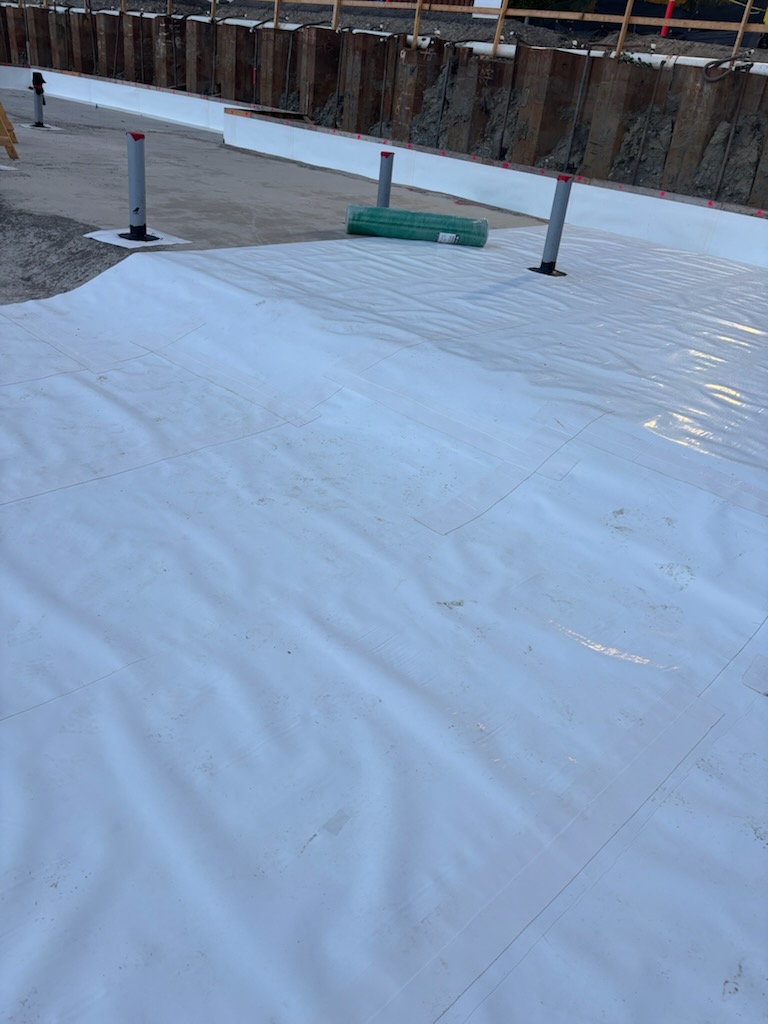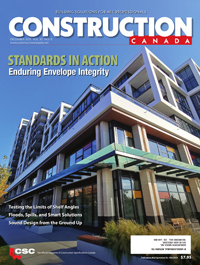Green Roofs: The Sky-high Solution to Stormwater Struggles
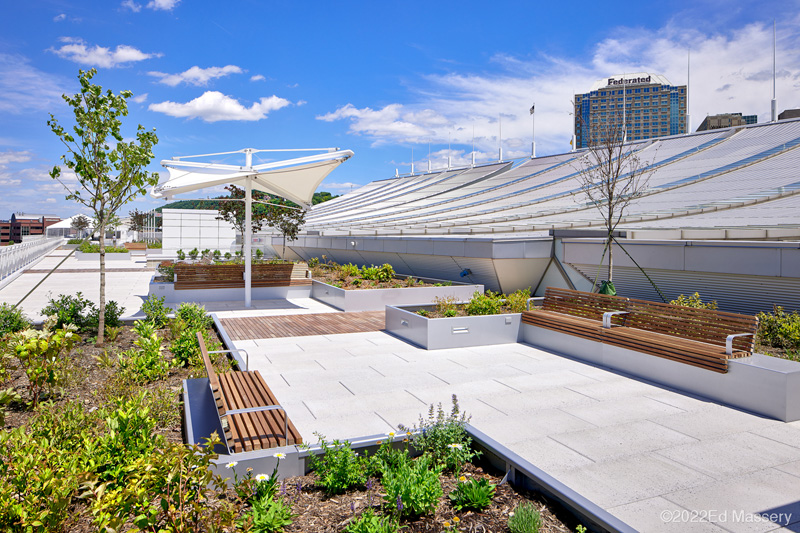
As urban areas expand and large-scale storms become increasingly common, stormwater management has become a critical challenge for cities across North America. Aging and under-sized infrastructure, climate change, and increasing impervious surfaces have intensified flooding risks and water pollution. Local municipalities are tasked with finding solutions to mitigate the impact on their communities by implementing various resolutions into their building codes.
Amid these pressing issues, vegetated roofs offer a promising solution—mitigating stormwater runoff, promoting sustainability, and enhancing urban resilience. By leveraging their inherent retention qualities and incorporating additional technologies to meet detention requirements, vegetated roofs, also known as green roofs, provide a sustainable approach to managing stormwater.
Although vegetated roofs and amenity spaces are recognized for a number of social, economic, and environmental benefits—including urban beautification and the use of underutilized spaces—stormwater management remains the largest driver of vegetated roofs around the world.
In North America, the effectiveness of vegetated roofs is particularly evident in large urban centres, such as New York City and Chicago. For regions prone to heavy rainfall or flooding, like the Eastern Seaboard, these systems can provide a buffer by retaining significant amounts of water. Leading the charge, municipalities such as Toronto are driving adoption by requiring or subsidizing vegetated roof installation with their Green Roof Bylaw. The first North American city to adopt this type of requirement, Toronto aimed to encourage the construction of green roofs both on city- and privately-owned buildings. More recently, New York City has implemented Local Law 92/94, which requires new construction and major roof renovations to install green roof or solar, with a primary goal of driving an additional 3.7 million L (1 million gal) of stormwater each year. These programs provide excellent examples of how cities can drive development to manage stormwater, while benefitting from the other benefits provided by vegetated roofing.
For building professionals, the challenges involve understanding local stormwater management codes and what strategies can be implemented to meet both retention and detention-based requirements. First, it is important to look at how vegetated roofing systems have developed over the years.
History of vegetated roofs
The concept of vegetated roofs dates back centuries, with early examples in Scandinavia, where sod roofs provided insulation for homes. In the 20th century, Germany pioneered modern green roof technology, emphasizing their environmental benefits. These innovations later spread to North America, where cities began exploring vegetated roofs as part of broader sustainability efforts.
Chicago’s City Hall is believed to be one of the earliest modern green roof assemblies in the U.S., leading to the city’s pioneering of green roof requirements. Before this, the first known green roof in New York City was built on Rockefeller Center in the 1930s. In recent years, New York City has further amplified its efforts with two new Sustainable Roof Laws adopted in 2019, requiring all new buildings and major renovations to have available roofing space covered by a vegetated roofing system, solar panels, or wind turbines.
Over the past two decades, materials, design, and installation advancements have made vegetated roofs more accessible and effective. Today, they are a cornerstone of sustainable urban development, recognized for their ability to address environmental and infrastructure challenges, including stormwater management.
Despite their proven benefits, vegetated roofs are sometimes misunderstood at the surface level. Perceived as purely decorative, green roofs are fully functional systems designed to manage stormwater, improve insulation, and have even proven to help extend the lifespan of a building’s roof. Although vegetated roofs may have higher upfront costs than traditional roofs, they offer a long-term return on investment (ROI) by reducing energy consumption, minimizing stormwater fees, and increasing property value.
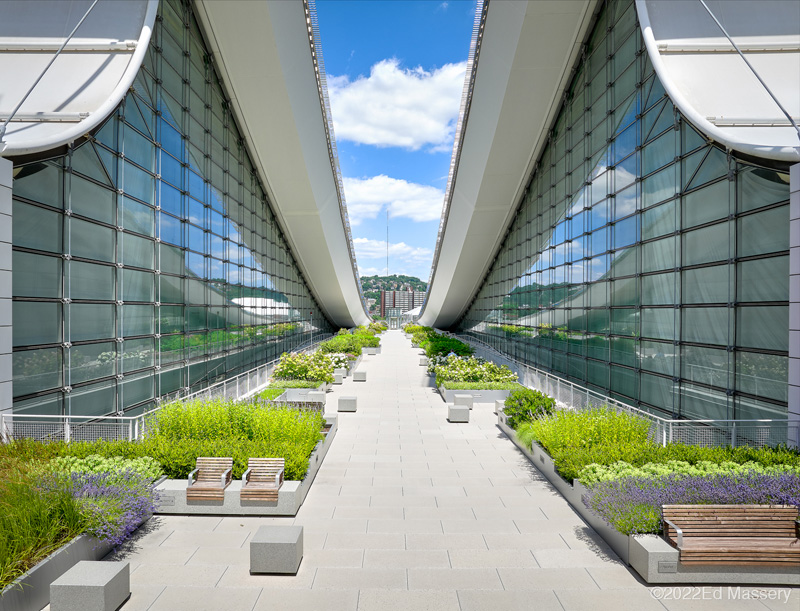
Advancements in materials and design have made vegetated roofs viable in a wide range of climates and building types. Proper plant selection—from sedums and succulents to large, mature trees—and irrigation systems ensure adaptability across commercial buildings for various needs.
Sustainable benefits
Beyond stormwater management, vegetated roofs provide additional sustainable benefits that enhance urban resilience. These systems improve insulation, increasing energy efficiency and reducing heating and cooling costs. They mitigate the urban heat island effect—where urban areas are 1 to 3 C (2 to 5 F) warmer than surrounding rural areas—through the cooling effects of evapotranspiration. Biophilic design, or incorporating nature into the built environment, including vegetated roofs and walls, has been proven to improve mental health, expedite healing times, encourage outdoor activity, and contribute to healthier communities. The environmental benefits extend further, as certain plant species improve air quality by filtering pollutants and noxious gases. Depending on the vegetation type, green roofs can boost biodiversity by creating habitats for pollinators and other wildlife essential for healthy ecosystems.
Incorporating green roofs into new developments and retrofits is a practical and impactful way to meet municipal regulations and sustainability targets. For commercial building consultants and architects, these systems represent a vital strategy for managing stormwater while building for a resilient, efficient, and environmentally conscious future.
The urban stormwater challenge
Stormwater runoff poses significant environmental and economic concerns for cities. When rain falls on traditional rooftops, streets, and other impermeable surfaces, it flows into storm drains, often carrying pollutants into waterways. During heavy rainfall, these systems can quickly become overwhelmed, leading to flooding, infrastructure damage, and costly repairs.
Traditional extensive vegetated roofs manage stormwater by retaining water within the profile of the growing media and any retention layers, which make the stored water available for plant use. While this aids in managing the stormwater for a project by reducing the overall volume entering the storm system, they do not address detention requirements, which seek to reduce the peak flow from a building. However, by integrating additional components within the vegetated roof profile, design teams can create space to park water while it is slowly released off a roof at a reduced, metered rate. This is usually achieved with a fixed aperture as part of the drain assembly. This helps cities mitigate flood risks and reduce the strain on overburdened stormwater systems, especially during peak rainfall. A notable example of an innovative approach to roofing is a multifaceted plan that incorporates vegetated roofing, amenity decks, and various waterproofing and roofing solutions.
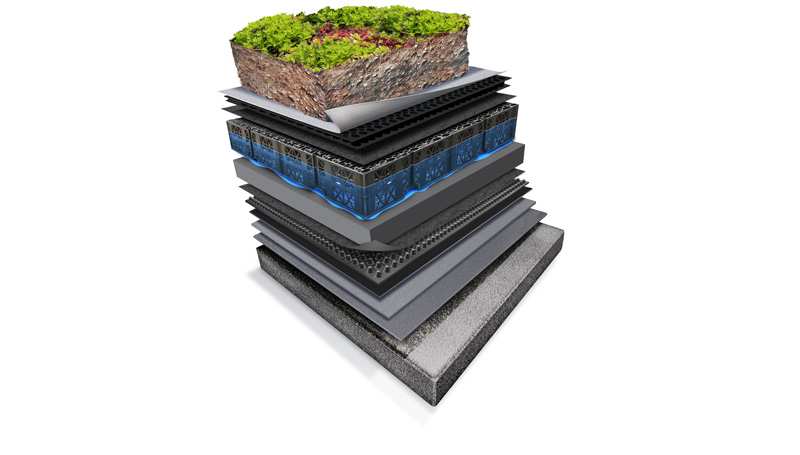
What builders should know about vegetated roofing
Vegetated roofs mimic natural landscapes to manage water sustainably. These systems are designed with multiple layers, each serving a specific purpose:
- Membrane—The protective layer responsible for keeping the structure watertight.
- Root barrier—Responsible for resisting root penetration of the membrane layer. A root barrier is not required with all membrane technologies, however, this should be co-ordinated with the membrane manufacturer.
- Drainage and retention layer—Responsible for providing drainage, retaining water for use by the plant material, and providing aeration to the bottom of the media profile.
- Growing media—A specialized soil layer composed of course aggregates, fine aggregates, and organic components with water and nutrient-holding capacity that provides structure for healthy root systems. Majority of the retention capacity of a vegetated roof is within the profile of the media.
- Vegetation—Plants absorb water and release it back into the atmosphere through evapotranspiration, integrating natural water cycles.
Inverted roof membrane assemblies typically include an additional drainage layer and insulation above the root barrier and below the drainage and retention layer.
A majority of municipalities include detention-based requirements that require water to be captured and held on-site for a duration of time and slowly released to the storm. Compared with at-grade landscapes, vegetated roofs do not possess the ability for stormwater to infiltrate the groundwater. The vegetated roof can retain a finite amount of water before the roof starts to release the water that has migrated through the assembly down the drain and away from the project. By integrating additional layers into the vegetated roof assembly, design teams can create space to temporarily store that detention requirement until it is released from the rooftop, as shown in Figure 1.
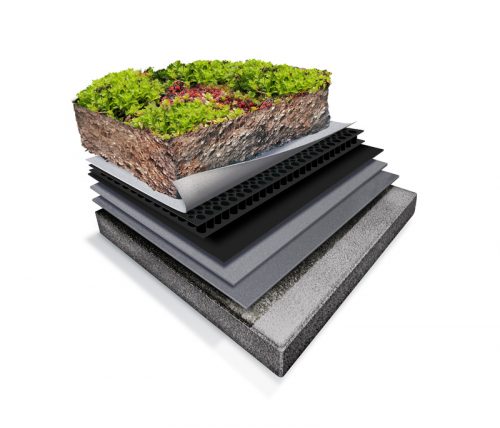
By combining these components, vegetated roofs reduce runoff volume and delay peak flow, providing an alternative solution to traditional stormwater management methods. In recent years, integrating modern advanced materials and design innovations has significantly enhanced the performance of vegetated roofs. Once based on esthetics, these systems are engineered to deliver many advantages.
Implementation
Stormwater management is critical for commercial building consultants and architects, particularly as sustainability becomes a central focus in modern construction. Understanding the role of advanced roofing systems in managing stormwater runoff is essential for designing environmentally responsible and efficient buildings.
Incorporating vegetated roofs into new projects effectively addresses stormwater management while enhancing the building’s sustainability profile. This process requires early integration into the planning and design stages to ensure compatibility with the roof’s structural load, waterproofing, and drainage systems. Collaborating with specialists during these stages can streamline implementation and improve outcomes.
Choosing the right materials is equally crucial. Appropriate waterproofing membrane selection, high-quality drainage and storage components, engineered media, and suitable plant selection ensure long-term functionality and resilience. Architects and consultants should also prioritize compliance with municipal regulations and sustainability benchmarks, optimizing the roof’s environmental and operational impact.
Projects well-suited for rooftop stormwater management are typically found in major urban centres, where buildings are constructed with zero lot lines. Sloping sites pose additional challenges, as water naturally seeks its level, often limiting storage to the site’s lowest point. High water tables and brownfield sites can complicate excavation efforts, making it difficult to install detention tanks below grade. If the project meets these criteria, using rooftop systems to store stormwater becomes a more financially viable option, as it avoids consuming valuable ground-level space.
Incorporating vegetated roofs into new projects requires thoughtful planning and collaboration. Best practices involve integrating these systems into the design process, ensuring compatibility with structural load, waterproofing, and drainage requirements. By addressing these factors early, consultants and architects can achieve optimal results while simplifying project execution. By leveraging the latest techniques and technologies, such as stormwater retention systems and advanced green roof designs, architects and building consultants can effectively mitigate runoff, promote urban sustainability, and align projects with forward-thinking environmental goals.
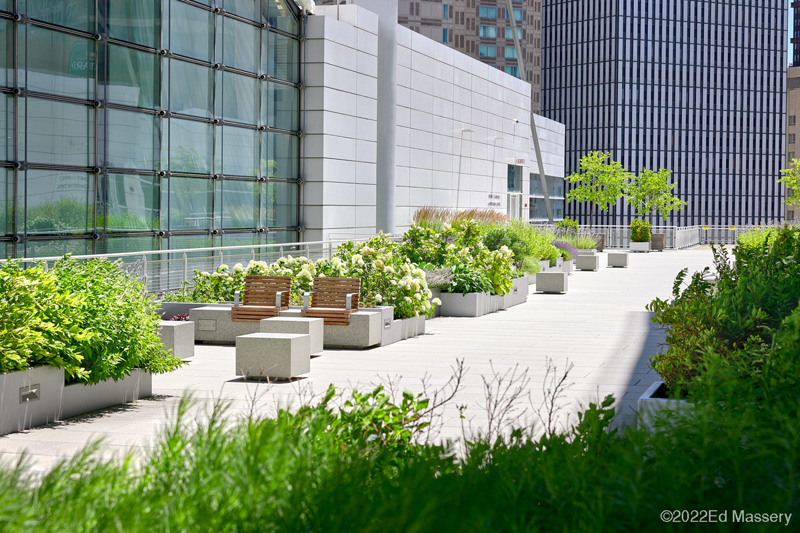
Consideration should be given to the additional loading posed on the structure. One cubic foot of water weighs approximately 28.3 kg (62.4 lb). It is critical to work with the civil engineer, structural engineer, and manufacturer to understand the loading a rooftop stormwater management system may impose on a structure. Although most roof systems will only need to manage a couple of inches of water, at 1 kg/m²/mm (5.2 lb/sf/in.) of thickness, it will likely affect the design of the structure.
In the face of heightened environmental and climate challenges, these living architectural features bring natural beauty to urban buildings and pave the way for architectural innovation. By embracing innovative solutions such as vegetated roofs, builders and policymakers can address today’s challenges while ensuring a sustainable future for future generations.
Author
Rick Kile, director of green and amenity business at Siplast, brings extensive experience in the construction industry and developed a strong foundation in landscape architecture and planning. His expertise lies in fostering innovative solutions that enhance both environmental sustainability and esthetic appeal. Kile’s passion for creating technically sound and functional on-structure landscapes has positioned him as a key player in advancing Siplast’s commitment to sustainable construction practices.



